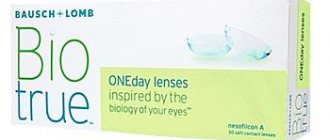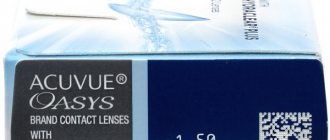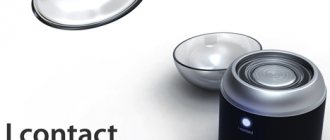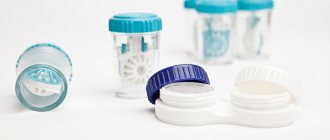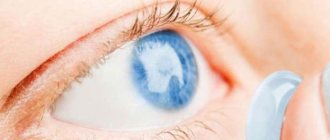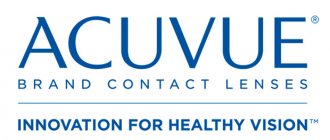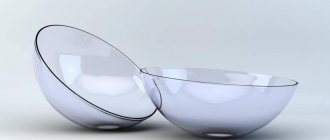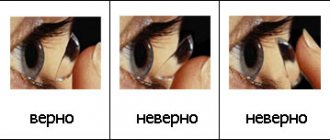The level of oxygen permeability of contact optics is one of the most significant parameters influencing the choice of model. Its size determines how well air will penetrate to the cornea. This property is determined by the characteristics of the polymer from which contact lenses are made. How do modern materials differ in terms of DCL level?
Our mucous membrane needs free access of oxygen from the environment. With its deficiency, hypoxia, corneal neovascularization, and inflammatory eye diseases can develop. The first contact correction products were made from hard polymers that did not allow oxygen to pass through easily, and they could be used for no more than a few hours. However, modern materials for the manufacture of contact optics have improved technical parameters and can be worn for quite a long time due to increased oxygen permeability.
Moisture content
Contact lenses are shaped to create a void between the model and the mucous membrane of the eyes. It is filled with tear fluid. This promotes comfortable wearing and hydration of the cornea. With the help of moisture, the model is not felt during use.
The formation of an internal moist layer helps to increase visual acuity. If the patient wears thick contact lenses or uses them for a long time, the wetness factor decreases. The eyes become dry and the cornea may become damaged.
Hydrogel-based contact lenses have been developed that retain moisture for a long time, ensuring wearing comfort. With the help of this base, the liquid is attracted to the lens, keeping the eye shell moisturized. The latest models of contact lenses are made of hydrogel.
What is the advantage of silicone hydrogel lenses?
They consist of two phases - silicone and hydrogel. They contain less water, but silicone works on the principle of a pump: it passes a sufficient amount of oxygen even in unfavorable conditions (during long periods of work at the computer, dust, dry air, etc.) and throughout the entire period of wearing. To compensate for the lack of moisture, moisturizing components are added to the material and the surface of optical products is treated using special plasma methods.
Oxygen permeability
Contact lenses are made in several layers. They must be porous to allow as much oxygen through as possible. This helps saturate the mucous membrane of the eyes with the element.
Prevents the formation of hypoxia, which damages the upper and inner layers of the eyes. The thicker and harder the contact lenses, the less oxygen they allow through. Currently, daily disposable contact lenses have been developed that are soft and thin. Their edges are as thin as possible to prevent tissue damage and allow as much oxygen through as possible.
Thin daily contact lenses have the greatest oxygen permeability. Models from 1 to 3 months are thicker, which is why the parameter is reduced in them. Only a small part of the oxygen passes through.
Terms of use
Reflects the maximum time of their use. Lenses available:
- Daily replacement, no maintenance required;
- Frequent scheduled replacement - replacement should be done after 1-2 weeks of use;
- Scheduled replacement - should be changed every 1-3 months;
- Traditional - requires replacement after 6-12 months.
Long-term lenses (more than 6 months) are available only in bottles. More frequent replacements are sold in blisters (packages in which sterility is maintained).
IMPORTANT: Manufacturers strongly discourage using lenses after their expiration date.
According to wearing mode there are:
Daily wear (DW). Removed at night.- Flexible wear (FW). Sometimes you can leave them overnight.
- Extended wear (EW). Can be used for up to 7 days in a row.
- Continuous wear (CW). Can be worn without removal for up to 30 days.
As a rule, the wearing mode depends on what the lenses are made of - dirtiness and moisture content of the material . Any user can easily choose the one that is suitable for themselves.
Optimal value of both parameters
There are 2 types of models: hydrogel and silicone hydrogel.
Silicone hydrogels are much more oxygen-permeable and thinner, but more rigid compared to hydrogel. The maximum oxygen permeability achieved for hydrogels is 42 DK/t, and for silicone hydrogels it is 175 DK/t. One-day clothes usually (but not always) have poor oxygen permeability, since people do not sleep in them.
Hydrogel contact lenses are designed for people who are used to inserting and removing a pair. Silicone hydrogel models are designed for patients who are just getting used to pairing. They have a denser base, so they are harder to tear.
The optimal level of moisture content and oxygen transmission is selected for each pair individually by the manufacturer. There is no single indicator of parameters. Each model is unique. During manufacturing, clinical tests are carried out, according to which the parameters of moisture content and oxygen permeability are selected. Manufacturers select the optimal parameters that are comfortable for consumers to wear.
Oxygen and moisture are indicators necessary to maintain eye health. Therefore, it is necessary to select more expensive lens models. They have maximum parameters, and you can feel them when using them. The Acuvue and Pure Vision line has the most suitable parameters.
Author's rating
Author of the article
Alexandrova O.M.
Articles written
2029
about the author
Was the article helpful?
Rate the material on a five-point scale!
( 5 ratings, average: 3.00 out of 5)
If you have any questions or want to share your opinion or experience, write a comment below.
Which ones are right for me?
Despite the fact that silicone hydrogel lenses allow oxygen to pass through better, hydrogel lenses are still not taken off the market; they are still popular. The fact is that when choosing, you need to take into account not only the reviews of other users, but also how a particular model suits your eyes in terms of many parameters (hardness, thickness, etc.). Therefore, you can choose contact optics only after consultation with a specialist, especially if you want to switch to a new type of lenses.
MagazinLinz.ru team
Which lenses are better to choose for six months?
Such optics are called traditional and, as a rule, are purchased for six months or even a year. In the EYETOP online store, traditional lenses are represented by manufacturers such as Maxima and Cooper Vision. It is better to buy such optics with a doctor's prescription, because they help correct vision defects and even compensate for corneal astigmatism (for example, LUNELLE ES70 UV).
An ophthalmologist will advise which lenses to choose, colored or clear. The color on Cooper Vision Ultra Flex tint lenses is applied subtly and clearly and is not recommended for wearing on very rare occasions.
Oxygen permeability of contact lenses
Oxygen permeability (Dk/l) is the most important indicator for the characteristics of the lens.
The metabolic processes occurring in the cornea of a healthy eye provide its main optical property - transparency. The content of a strictly defined amount of water (78%) is maintained by the functioning of the “epithelial-endothelial pump”, which requires significant energy costs. The cornea receives energy with the participation of oxygen as a result of the breakdown of glucogen from the epithelium, as well as glucose from the epithelium and endothelium. Since the health of the cornea depends on the continuous supply of sufficient oxygen, the oxygen permeability of contact lenses is the most important criterion for their tolerability.
The cornea receives the necessary oxygen directly from atmospheric air and tear fluid, which is wetted during blinking. When the eyelids are closed, oxygen enters the cornea through the blood vessels of the conjunctiva of the eyelid, the capillaries of the limbal zone, as well as from the moisture of the anterior chamber of the eye, so three times less oxygen enters the closed eye than the open eye. Conventional contact lenses are a barrier that prevents oxygen from entering the eye directly from the atmospheric air. In this case, the supply of oxygen can occur in two ways: 1) during the exchange of tear fluid between the lens and the eye during blinking; 2) directly through the lens material.
When wearing contact lenses, the frequency of blinking increases, which is one of the protective properties of the eye, helping to accelerate the exchange of tear fluid. Changing the tear fluid in the space under the lens not only provides the cornea with oxygen and essential nutrients, but also removes the products of its metabolism (oxygen dioxide, lactic acid) and dead epithelial cells. But the tear pump alone cannot provide sufficient oxygen to the cornea, so lenses must be made of a material with high gas permeability.
Oxygen permeability is the rate at which oxygen passes through a unit area of contact lens material of a certain thickness, and is expressed by the formula DK/L, where D is the diffusion coefficient of oxygen, K is the gas distribution coefficient at the polymer-air interface, L is the thickness of the material.
With conventional soft contact lenses, oxygen reaches the cornea directly through a moisture-containing polymer matrix. An increase in oxygen diffusion in such lenses can be achieved by reducing the thickness of the lens and increasing the moisture content of the material. However, soft contact lenses with high moisture content reduce their strength, so for ease of use they are made thicker. But an increase in thickness leads to a decrease in DK/L.
As a result of numerous studies, the following criteria for oxygen permeability have been established:
For daily wear lenses, DK/L must be at least 24 x10-9. For extended wear lenses, DK/L must be at least 87 x10-9.
That is, the higher the DK/L index (sometimes written DK/t ) of the lenses, the better your eyes are supplied with oxygen. See this Price indicator in the DK/L column
We do not have reliable data on DK/L lenses of Russian, Moldavian, Ukrainian production . If you know of them, please let us know
The EYETOP online store offers the widest range of lenses:
- one-day (Bauch & Lomb, Ciba Vision, Coopervision and Johnson & Johnson);
- for 2 weeks (Johnson & Johnson);
- for 1 month (Bauch & Lomb, Ciba Vision, Clear Lab, Coopervision and Maxima);
- for 3 months (Bauch & Lomb, Interojo, OKVision and Ophthalm Renaissance);
- traditional (Coopervision and Maxima).
In this review, we will tell you everything about contact lenses: which ones are better to choose, how they differ and which brand you should give preference to. We will talk about the features of each type of optics and analyze their features and disadvantages in detail.
If our review helped you understand which contact lenses are better and decide on the type of optics, you can instantly order it in our online store. All you need to do to do this is follow the link to the appropriate catalog page.
What lens material is best for two-week optics?
Silicone hydrogel lenses have long established themselves as the most comfortable and high-quality. They breathe and do not dry out the eyes thanks to the silicone component, as well as the Hydraclear component. In the EYETOP store you can buy two-week Johnson & Johnson lenses:
- Acuvue-2;
- Acuvue-2 Hydraclear Plus 2;
- Acuvue-2 Hydraclear Plus.
In addition, the manufacturer offers not only clear lenses, but also Acuvue-2 Colors Enhancer tint lenses. Whatever Acuvue contact lenses for 2 weeks you choose, you can wear them without removing them at night for one week or for 2 weeks - only during the day.
Purpose
Contact lenses differ from each other not only in material, shape, size, but also in what problems they are supposed to solve.
Correction of visual impairments
Such lenses are called optical and there are several types :
Spherical/aspherical used to correct farsightedness (hypermetropia) and nearsightedness (myopia).- Toric ones are used to correct astigmatism. The front part of such a product has a spherocylindrical shape, while the radius of curvature gradually increases, reducing astigmatism to a minimum. Visual acuity in such lenses will be higher than in glasses.
- Multifocals correct several visual impairments. Such disorders occur with presbyopia - an age-related change in the eye when the eyes do not focus on an object at a close distance (age-related farsightedness). These lenses allow you to seamlessly transition from reading at close range to objects located at a normal distance. Important characteristics of this type are dominance and addition, which must be taken into account when selecting.
Cosmetic and decorative
Today there is a great variety of them. They can be colored, tinted, with patterns, with an unusual pupil shape, and so on. Such lenses block the iris and can change the color of the eyes. They can be without diopters or simultaneously correct vision.
Dimensions
Depending on the diameter there are:
- Scleral – 13-24 mm. Cover the completely visible sclera. They are used more often after eye surgeries or as a decorative element.
- Corneal - from 9 to 11 mm. They are tough.
- Corneoscleral – 12-15 mm. They are soft contact lenses.
There is also such a thing as the radius of curvature of a lens - a characteristic of the curvature of its inner surface. It is responsible for the comfortable fit of the product on the eye, so the curvature of the cornea must correspond to it. The radius varies from 7.8 to 9.5 mm. Manufacturers more often produce lenses with a standard radius of curvature - 8.6 mm, which is suitable for most users.
IMPORTANT: An unsuitable radius of curvature for the eye can lead to unpleasant consequences - decreased vision, discomfort, and corneal edema.
Production technology
Currently, the production of soft contact lenses is carried out in four ways, each of which has its own disadvantages and advantages.
Mold casting
The method is characterized by high reproducibility, low price and good quality optics.
In addition, using this method it is possible to produce products with complex geometries, for example, toric ones. However, it is not always possible to produce high diopters and a long service life.
Turning
This method can produce lenses with almost any given parameters. They have good centering and mobility, are easy to handle, as they have optimal thickness and elasticity.
But they have low oxygen permeability and are less comfortable to wear. Their cost is quite high, and it is more difficult to select them. In addition, defects are often detected on the surface of the product.
Centrifugal casting
Products made in this way are thin and elastic, very comfortable to wear. They have high repeatability of parameters and are easy to select.
The disadvantage is the inability to produce products with complex geometries and more difficult handling due to the low thickness. In addition, there may be a mismatch between the surfaces of the product and the cornea.
Combined method
The method consists of a combination of two production methods: the outer surface is cast by centrifugal molding, and the inner surface is cast by turning.
The output is high optical characteristics, optimal centering and mobility, and ease of wearing. The outer surface is very smooth, it itself is durable and elastic.
The disadvantage is the longer manufacturing process.
Here is an interesting video about the production of contact lenses:
